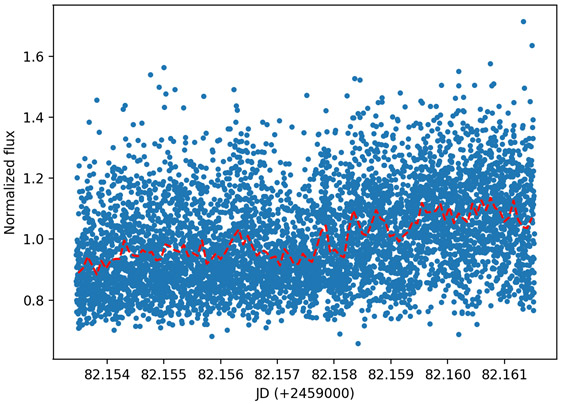Resources
 Part of the Oxford Instruments Group
Part of the Oxford Instruments Group
Expand
Collapse
 Part of the Oxford Instruments Group
Part of the Oxford Instruments Group
During the last decade, the successful operation of many ground-based (for example, CARMENES) and satellite (Kepler, TESS, eROSITA) surveys, usually for extrasolar planets, has led to an almost exponential increase in the demand for photometric follow-up observations of these stars. In many cases, the precision required to study the photometric variations of given phenomena (e.g., exoplanet transits) is high. As a result, the elimination of instrumentally induced errors is vital to achieving the needed photometric precision. Such systematic errors can be introduced from the detector (camera) and the mount or the optics of the telescope itself.
One of the most extensively used ways to reduce the systematic errors in photometric datasets is by subtracting the bias/dark/flat calibration frames. However, unavoidable imperfections in the tracking gears of the telescope’s mounting system usually introduce movements in pixel scale values, which, combined with systematic errors in the optics of the telescope, can lead to additional tracking related noise in the light curves, leading to the necessity for high-time resolution. The Andor back-illuminated sCMOS camera Marana-4BV11 (2048 x 2048 x 11 µm pixels) is ideal for such studies. Specifically, along with the common - in astronomical cameras - features like cooling also allows for high-speed observations. Furthermore, its high quantum efficiency allows for more precise observations of fainter stars and the easier use of filters when chromatic information is also required.
Our Andor Marana sCMOS is mounted on the Planetary Transit Study Telescope (PTST), located at the La Sagra Observatory in Spain. The combination of the PTST optical system (PlaneWave CDK 24) with the large sCMOS sensor of the Marana allows for observations with a relatively wide field (about 20 arcmin x20 arcmin) and thus the study of more sources, which is crucial for better results with differential photometry. The camera is connected to a Linux PC and operated using Andor’s Software Development Kit for Linux along with custom Python scripts.
Our group intends to use the PTST, equipped with the Marana sCMOS camera, for a series of follow up observations related to stellar activity studies. In 2018, the Transiting Exoplanet Survey Satellite (TESS) launched and started operations, an all-sky survey dedicated to detecting exoplanet transits using photometry. About half (i.e., 47.8 %) of the sky observed by the TESS satellite will receive an exposure of only 27 days. For the stars located in parts of the sky with a coverage of 27 days and with evidence that the detected rotation periods may be close or exceed 15 days (i.e., about half of the total exposure time), we plan to observe them with PTST. Furthermore, we plan to continue observing active stars with transiting exoplanets to understand better their properties - both the stars and the planets.
Another study related to the stellar activity is observing flaring stars detected from the X-ray satellite survey e-ROSITA. The goal is to observe such stars with the hope that additional flares will occur during our observations. Using the high-speed potential of the Marana, we can then sample the flare events in much better detail.
To illustrate the performance of the Marana sCMOS camera, we consider the case of the δ-scuti variable star ε-Cep.

Figure 1 Light curve produced using differential aperture photometry.
Figure 1 shows an 11 min excerpt of the light curve produced using differential aperture photometry, i.e., the measurement of the sum of the counts in every pixel illuminated by a given star in each frame. The final form of the light curve results from the initial photometry correction using a comparison star in the same frames as ε-Cep. This process aims at removing any non-stellar related variations (e.g., introduced by the airmass's continuous change during the observation). The observations were made using 0.05 sec exposures and a frame rate of 8 frames per second. In this high frame rate/low exposure observations, it is possible to monitor the Earth atmosphere's scintillation, which in Fig. 1 appears as the ~50 % variation in photometric flux. Understanding the properties of scintillation noise can improve our understanding of red noise in the light curves of stars observed with Earth-based telescopes. The red line shows the same light curve, binned in bins of 10 secs, where one can observe a part of the variation introduced by ε-Cep itself which has a period of about one hour.
Contact
Dr. Panos Ioannidis
Hamburg Observatory
Physics Department
University of Hamburg
Gojenbergsweg 112
21029 Hamburg
Germany
Phone: +49 (40) 428 388 420
E-Mail: pioannidis@hs.uni-hamburg.de
Web: http://www.hs.uni-hamburg.de
Date: October 2020
Author: P. Ioannidis & J.H.M.M. Schmitt, Hamburg Observatory, University of Hamburg, Germany
Category: Application Note
